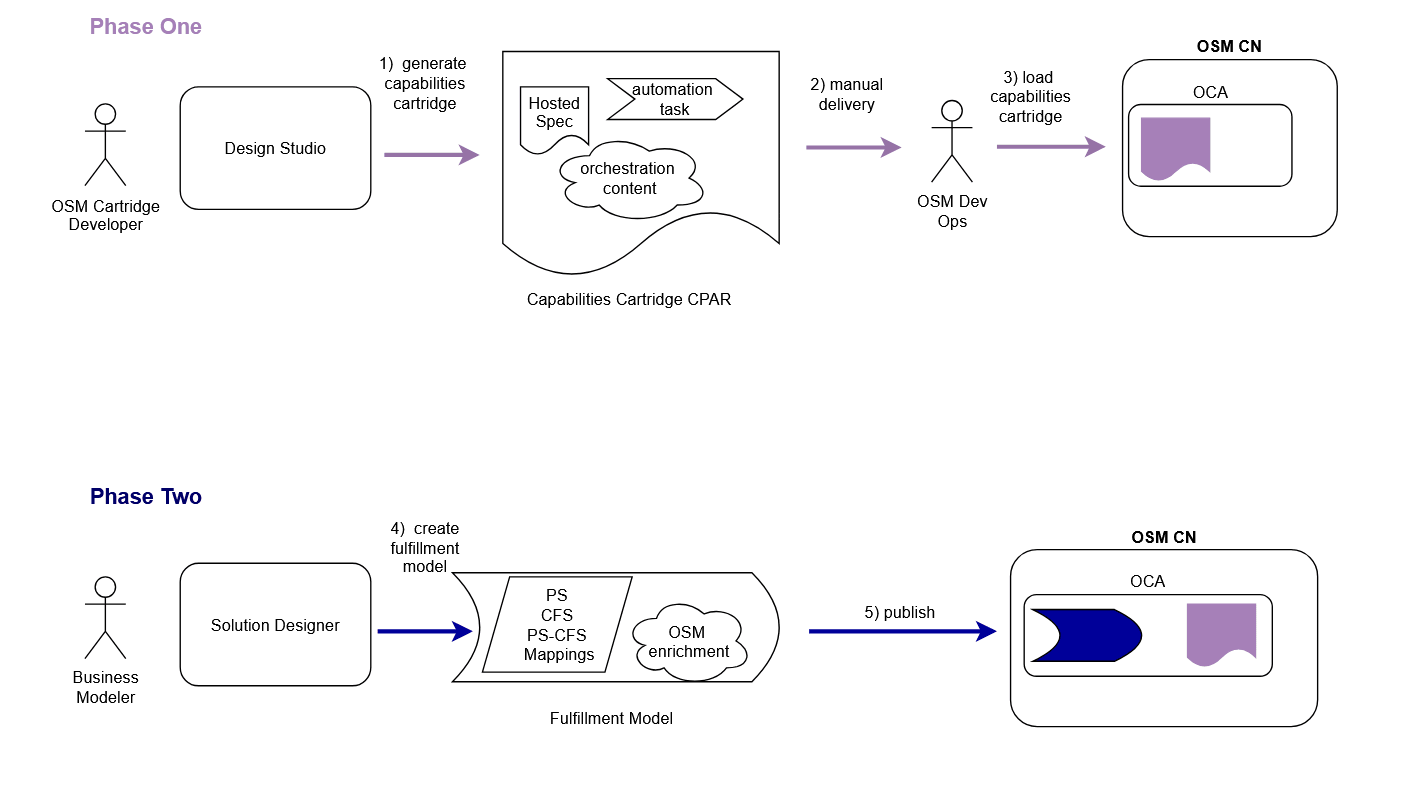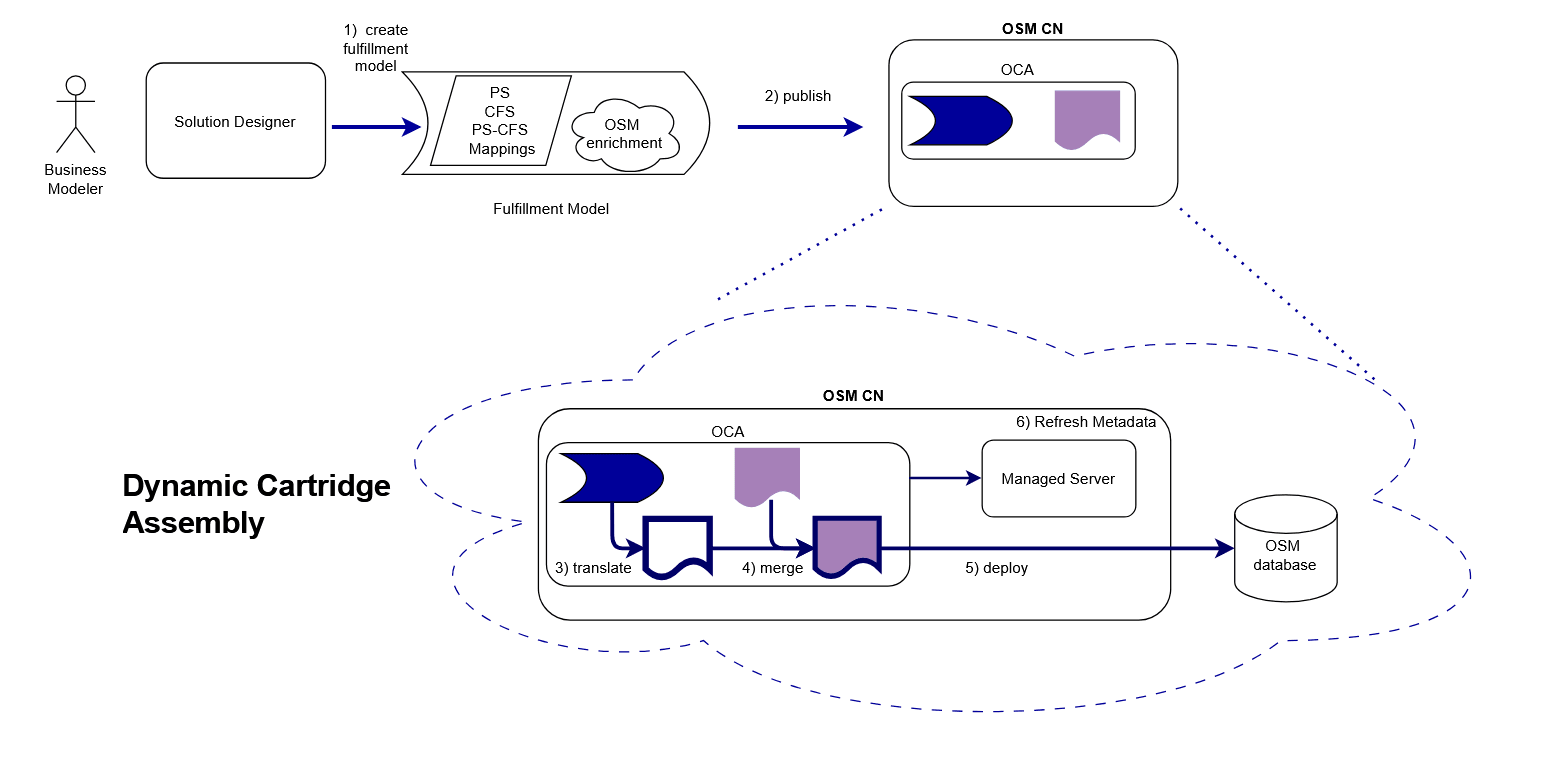9 About Dynamic Cartridge Assembly (Cloud Native Only)
This chapter provides conceptual information about OSM's dynamic cartridge assembly feature for TMF cartridges.
Prior to OSM 8.0, Design Studio was the sole application for design-time creation of OSM cartridges. With the release of OSM 8.0 and Service Catalog and Design (SCD) 8.3, the SCD Solution Designer web application is now available for OSM, enabling additional flexibility in the design-time definition of OSM cartridge content.
This enhancement reduces the overall cost of cartridge development by streamlining processes and accommodating product and service catalog related changes more efficiently. It also recognizes the diverse personas involved in cartridge development. It provides an alternative to the technical Design Studio application. This allows users to contribute meaningfully within Solution Designer, regardless of their level of technical knowledge, supporting broader collaboration and faster content creation.
When cartridge design activities span both Design Studio and Solution Designer, a mechanism is required to merge the content produced in the two applications and facilitate deployment to OSM. This is done by the OSM Cartridge Assembler (OCA) microservice. For more information about installing OSM Cartridge Assembler (OCA), see Installing OSM Cartridge Assembler (OCA) for Integration with Solution Designer.
OCA brings the Dynamic Cartridge Assembly capability to the distributed design journey by integrating inputs and performing a seamless deployment process.
Refer to About Service Catalog and Design for an introduction to Solution Designer. Refer to the OSM Compatibility Matrix for the version of SCD applications that work with your OSM release.
About the Design Journeys
Traditional Design Journey
The traditional OSM cartridge development design time journey takes place fully in Design Studio. The OSM cartridge developer defines all the content that is required for processing, performs a build and then deploys the cartridge to an OSM instance. The deployment can be done using Design Studio or other mechanisms. This is typically an iterative process.
Dynamic Design Journey
The dynamic design time journey spans both Design Studio and Solution Designer. This process produces the signal that triggers OSM Cartridge Assembler (OCA) to perform the Dynamic Cartridge Assembly.
About the Dynamic Design Journey
The introduction of Solution Designer expands the OSM cartridge development process into a dynamic, two-phase design journey. This approach enables both technical and non-technical users to participate in cartridge creation, tailoring the process to fit a range of skills and project requirements.
About the Capabilities Cartridge
The dynamic design journey introduces a key artifact called a capabilities cartridge. This consists of a set of reusable OSM entities such as order template, order item specification, order components, fulfillment patterns.
Note:
Only TMF cartridge content can be packaged as a capabilities cartridge.Refer to Working with Capabilities Cartridges (Cloud Native Only) for more information about working with a capabilities cartridge in Design Studio, including the restrictions and limitations.
Refer to About OSM Participant in Service Catalog and Design Solution Designer User's Guide for more information about generating a capabilities cartridge artifact.
Phase 1: Capabilities Cartridge Development in Design Studio
The first phase is led by the technical cartridge developer, using the Design Studio environment. The process in this phase is what developers do in the traditional design journey of iterative development and test cycles to build their cartridges.
Key activities performed in this phase include:
- Defining technical entities, behaviors, and orchestration logic.
- Implementing complex business rules and integrations.
- Defining a set of test data so that the orchestration logic can be validated through runtime order processing.
- Repeating the building and deployment cycle until testing confirms correct cartridge processing.
Once the traditional development and testing cycle is complete, you prepare for the dynamic journey by re-packaging the workspace into a capabilities cartridge.
- A .cpar file which is an archive of reusable OSM content that is exposed in Solution Designer. This is not a deployable artifact. This needs to be delivered to your OSM cloud native instance (specifically the OCA microservice) that is connected to Solution Designer. Refer to "Building Capabilities Cartridge Image" and Installing OSM Cartridge Assembler (OCA) for Integration with Solution Designer in OSM Cloud Native Deployment Guide for more information.
- A capabilitiesManifest.json file that describes the reusable components that are made available in the .cpar file.
Note:
Design Studio provides the customizability and flexibility required by technical experts to architect comprehensive and robust cartridge logic.Phase 2: Business Modeling in Solution Designer
The second phase empowers the business modeler - a user who does not need cartridge development expertise - to leverage the reusable content from the capabilities cartridge, to define an order processing cartridge using Solution Designer. In this web-based tool, business modelers can:
- Configure product catalog content including products (PS), services (CFS) and PS-CFS attribute mappings.
- Link the product catalog to the relevant OSM content sourced from the capabilities cartridge. For example, a PS (defined in Solution Designer) is mapped to a fulfillment pattern (defined in the Capabilities Cartridge).
This phase provides a user-friendly interface that leverages the business modeler's specific knowledge and enables faster responses to evolving modeling requirements. Since dynamically built cartridges are largely reusing tested and delivered content from the capability cartridge, along with generated configuration, this approach removes the regression risk associated with repeated cartridge development iterations.
About Dynamic Cartridge Assembly
Dynamic cartridge assembly is a key capability used to streamline and modernize OSM cartridge management in environments where SCD's Design Studio and Solution Designer are both used. It allows users from both technical and business domains to effectively collaborate and contribute to cartridge development while ensuring operational consistency and agility.


